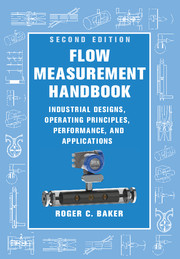Book contents
- Frontmatter
- Dedication
- Contents
- Preface
- Acknowledgements
- Nomenclature
- 1 Introduction
- 2 Fluid Mechanics Essentials
- 3 Specification, Selection and Audit
- 4 Calibration
- 5 Orifice Plate Meters
- 6 Venturi Meter and Standard Nozzles
- 7 Critical Flow Venturi Nozzle
- 8 Other Momentum-Sensing Meters
- 9 Positive Displacement Flowmeters
- 10 Turbine and Related Flowmeters
- 11 Vortex Shedding, Swirl and Fluidic Flowmeters
- 12 Electromagnetic Flowmeters
- 13 Magnetic Resonance Flowmeters
- 14 Ultrasonic Flowmeters
- 15 Acoustic and Sonar Flowmeters
- 16 Mass Flow Measurement Using Multiple Sensors for Single-Phase Flows
- 17 Multiphase Flowmeters 508
- 18 Thermal Flowmeters
- 19 Angular Momentum Devices
- 20 Coriolis Flowmeters
- 21 Probes for Local Velocity Measurement in Liquids and Gases
- 22 Verification and In Situ Methods for Checking Calibration
- 23 Remote Data Access Systems
- 24 Final Considerations
- References
- Main Index
- Flowmeter Index
- Flowmeter Application Index
7 - Critical Flow Venturi Nozzle
Published online by Cambridge University Press: 05 August 2016
- Frontmatter
- Dedication
- Contents
- Preface
- Acknowledgements
- Nomenclature
- 1 Introduction
- 2 Fluid Mechanics Essentials
- 3 Specification, Selection and Audit
- 4 Calibration
- 5 Orifice Plate Meters
- 6 Venturi Meter and Standard Nozzles
- 7 Critical Flow Venturi Nozzle
- 8 Other Momentum-Sensing Meters
- 9 Positive Displacement Flowmeters
- 10 Turbine and Related Flowmeters
- 11 Vortex Shedding, Swirl and Fluidic Flowmeters
- 12 Electromagnetic Flowmeters
- 13 Magnetic Resonance Flowmeters
- 14 Ultrasonic Flowmeters
- 15 Acoustic and Sonar Flowmeters
- 16 Mass Flow Measurement Using Multiple Sensors for Single-Phase Flows
- 17 Multiphase Flowmeters 508
- 18 Thermal Flowmeters
- 19 Angular Momentum Devices
- 20 Coriolis Flowmeters
- 21 Probes for Local Velocity Measurement in Liquids and Gases
- 22 Verification and In Situ Methods for Checking Calibration
- 23 Remote Data Access Systems
- 24 Final Considerations
- References
- Main Index
- Flowmeter Index
- Flowmeter Application Index
Summary
Introduction
This meter makes use of a fascinating effect which occurs when gas flows at very high velocity through a nozzle. As the gas is sucked through the nozzle the velocity increases as the cross-section of the nozzle passage decreases towards the throat. At the throat the maximum velocity which can be achieved is sonic – the speed of sound. Downstream of the throat, the velocity will either fall again returning to subsonic, or will rise and become supersonic. In normal operation of the nozzle, the supersonic region is likely to be small, and to be followed by a shock wave which stands across the divergent portion of the nozzle, and causes the gas velocity to drop, very suddenly, from supersonic to subsonic. The existence of the shock wave does not mean that one will hear a “sonic boom”! Such booms are usually caused by moving shock waves carried forward by high-speed aircraft.
The fascinating effect of sonic conditions at the throat is that changes in the flow downstream of the throat have no effect on conditions upstream. The sonic or critical or choked condition, as it is called, appears to block any information which is trying to penetrate upstream. A simple picture of this is that the messengers carrying such information travel at the speed of sound, and so they are unable to make any headway over the fast-flowing gas stream.
Two important effects of this are that:
i) the mass flow rate is a function of the gas properties, the upstream stagnation temperature and pressure and the area of the throat, provided that the nozzle is actually running at critical conditions (which can be ascertained by checking the downstream pressure);
ii) the nozzle acts as a flow controller, creating steady conditions upstream even though conditions downstream are unsteady.
Figure 2.6(a) shows a simple illustration of a convergent-divergent nozzle with a throttle valve downstream. Figure 2.6(b) shows the variation of pressure through the nozzle, and the critical flow conditions are those bounded by curves c and i for which the flow becomes sonic at the throat.
- Type
- Chapter
- Information
- Flow Measurement HandbookIndustrial Designs, Operating Principles, Performance, and Applications, pp. 177 - 194Publisher: Cambridge University PressPrint publication year: 2016



